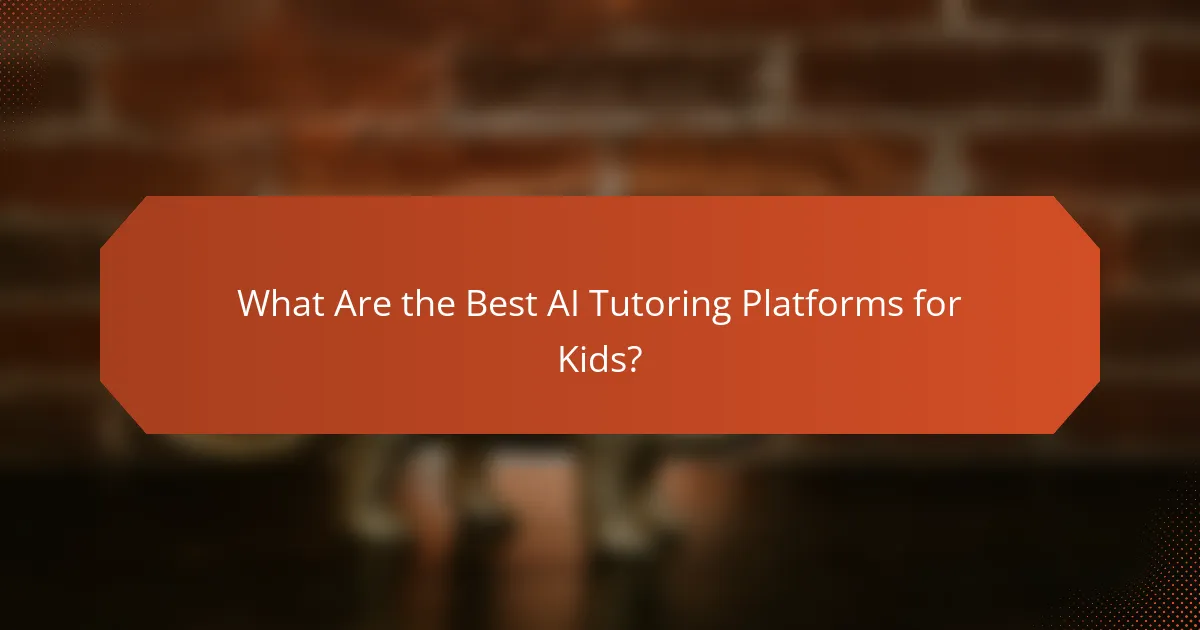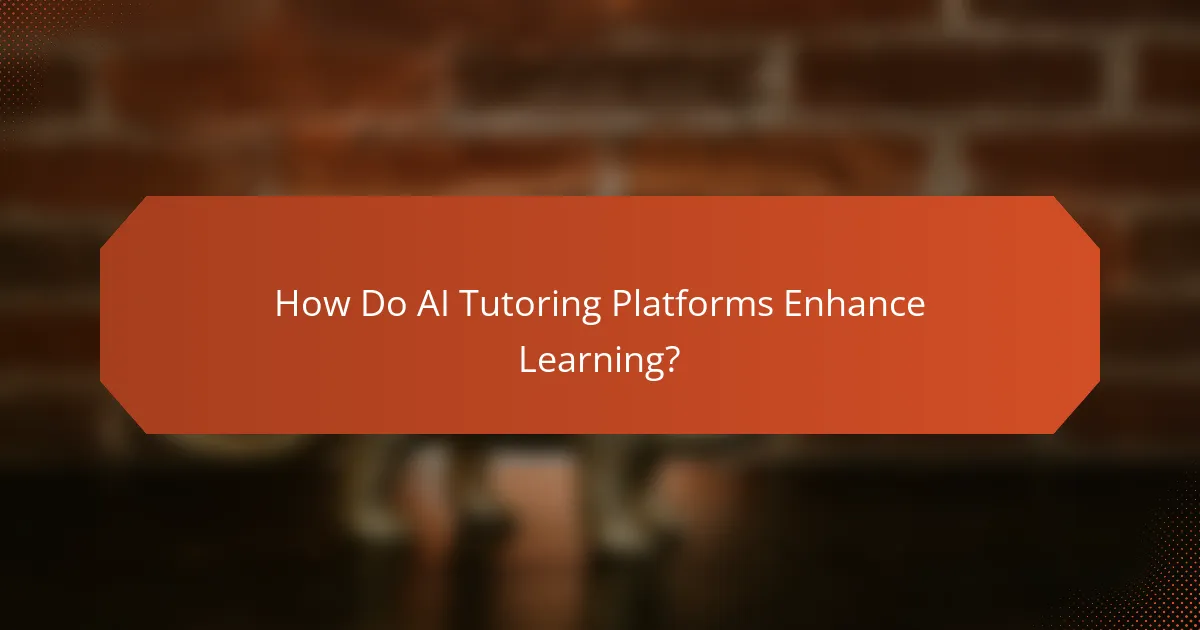AI tutoring platforms for kids are designed to create engaging and interactive learning experiences that cater to individual needs. By leveraging advanced algorithms, these platforms adapt to each child’s learning pace and style, making education both accessible and enjoyable. Parents should look for user-friendly interfaces and effective progress tracking to ensure a meaningful and age-appropriate learning journey for their children.

What Are the Best AI Tutoring Platforms for Kids?
The best AI tutoring platforms for kids offer engaging, interactive learning experiences tailored to young learners. These platforms utilize artificial intelligence to adapt to each child’s learning pace and style, making education more accessible and enjoyable.
Khan Academy Kids
Khan Academy Kids is a free educational app designed for children ages 2 to 8. It features a wide range of subjects, including math, reading, and social-emotional learning, all presented through engaging activities and animated characters.
The platform uses adaptive learning technology to personalize lessons based on a child’s progress, ensuring that they are challenged appropriately. Parents can track their child’s development through detailed progress reports.
Duolingo ABC
Duolingo ABC is a free app aimed at teaching young children the basics of reading and writing. It is designed for kids aged 3 to 6 and employs fun games and stories to keep learners engaged.
The platform focuses on phonics, vocabulary, and comprehension skills, using bite-sized lessons that can be completed in just a few minutes. This makes it easy for children to learn in short bursts, fitting into busy schedules.
DreamBox Learning
DreamBox Learning is an adaptive math program for students in kindergarten through eighth grade. It provides personalized lessons that adjust in real-time based on a child’s responses, ensuring they grasp concepts before moving on.
The platform emphasizes problem-solving and critical thinking, offering interactive lessons that can be accessed on various devices. DreamBox also provides insights for parents and teachers to help support the child’s learning journey.
Prodigy Math
Prodigy Math is a free, game-based learning platform that helps children in grades 1 to 8 improve their math skills. It combines a fantasy game environment with curriculum-aligned math challenges, making learning fun and engaging.
Students can play at their own pace, and the platform adapts to their skill level, providing practice on topics they need to master. Teachers and parents can monitor progress through detailed reports, allowing for targeted support.
ABCmouse
ABCmouse is a comprehensive early learning platform for children ages 2 to 8, covering subjects such as reading, math, art, and science. It offers a structured curriculum with thousands of activities, including games, books, and songs.
While ABCmouse requires a subscription, it provides a wealth of resources designed to keep young learners engaged. The platform’s progress tracking allows parents to see how their child is advancing through the curriculum.

How Do AI Tutoring Platforms Enhance Learning?
AI tutoring platforms enhance learning by providing tailored educational experiences that adapt to each child’s unique needs. These platforms leverage advanced algorithms to create personalized learning paths, engage students interactively, and offer real-time feedback, making learning more effective and enjoyable.
Personalized Learning Paths
Personalized learning paths are designed to cater to the individual strengths and weaknesses of each student. By assessing a child’s knowledge and learning style, AI tutoring platforms can create a customized curriculum that progresses at an appropriate pace. This ensures that students remain challenged without feeling overwhelmed.
For example, if a child excels in math but struggles with reading, the platform can allocate more time and resources to reading exercises while maintaining math challenges. This targeted approach helps maximize learning efficiency.
Interactive Engagement Features
Interactive engagement features are crucial for maintaining a child’s interest and motivation in learning. Many AI tutoring platforms incorporate gamification elements, such as rewards, challenges, and interactive quizzes, to make learning fun. These features encourage active participation rather than passive consumption of information.
Additionally, platforms may include interactive simulations or virtual environments where students can practice skills in a hands-on manner. This not only enhances understanding but also promotes retention of knowledge through experiential learning.
Real-Time Feedback
Real-time feedback is a key advantage of AI tutoring platforms, allowing students to receive immediate responses to their work. This instant feedback helps learners identify mistakes and understand concepts more deeply, facilitating quicker mastery of subjects. It also fosters a growth mindset by encouraging students to learn from their errors.
For instance, when a student answers a question incorrectly, the platform can provide hints or explanations right away, guiding them toward the correct answer. This immediate support can significantly improve learning outcomes and confidence in their abilities.

What Features Should Parents Look For?
Parents should prioritize user-friendly experiences, effective progress tracking, and age-appropriate content when selecting AI tutoring platforms for their children. These features ensure that learning is engaging, measurable, and suitable for their child’s developmental stage.
User-Friendly Interfaces
A user-friendly interface is crucial for keeping kids engaged with AI tutoring platforms. Look for platforms that feature intuitive navigation, bright visuals, and interactive elements that capture children’s attention. A clean layout with clear instructions can help minimize frustration and enhance the learning experience.
Platforms should also be accessible on various devices, including tablets and smartphones, allowing children to learn anytime and anywhere. Test the interface yourself to ensure it is easy for your child to use independently.
Progress Tracking Tools
Effective progress tracking tools allow parents to monitor their child’s learning journey. Look for platforms that offer dashboards displaying performance metrics, such as completed lessons, quiz scores, and skill mastery levels. These insights can help identify areas where your child excels or needs additional support.
Some platforms may also provide personalized feedback and recommendations based on your child’s progress. This feature can guide parents in facilitating discussions about learning goals and achievements.
Age-Appropriate Content
Age-appropriate content is essential for maintaining a child’s interest and ensuring they are learning at the right level. Choose platforms that offer materials tailored to your child’s age group and learning style, whether they are in early elementary or middle school.
Additionally, consider platforms that align with educational standards relevant to your region, such as Common Core in the U.S. or the National Curriculum in the U.K. This alignment can help ensure that the content supports what your child is learning in school.

How Do Pricing Models Vary Among AI Tutoring Platforms?
Pricing models for AI tutoring platforms can differ significantly, impacting how families choose services. Common models include subscription plans, one-time purchases, and promotional offers like free trials or discounts.
Subscription-Based Models
Subscription-based models typically charge a recurring fee, often monthly or annually, providing access to a range of tutoring resources. Prices can vary widely, generally falling between $10 to $50 per month, depending on the platform’s features and content quality.
These models often include benefits such as unlimited access to lessons, personalized learning paths, and ongoing updates. However, families should consider their child’s learning needs and whether they will use the service consistently to justify the cost.
One-Time Purchase Options
One-time purchase options allow users to pay a single fee for specific courses or tutoring sessions. This model can range from $20 to several hundred dollars, depending on the depth and duration of the content offered.
This approach is beneficial for families who prefer not to commit to ongoing payments. However, it may limit access to additional resources or updates that subscription models provide, so it’s essential to evaluate the long-term value.
Free Trials and Discounts
Many AI tutoring platforms offer free trials or introductory discounts to attract new users. These trials typically last from a week to a month, allowing families to assess the platform’s effectiveness without financial commitment.
Taking advantage of these offers can help determine if the service meets a child’s educational needs. However, be cautious of automatic renewals after the trial period, which can lead to unexpected charges if not canceled in time.

What Are the Benefits of Using AI Tutoring Platforms?
AI tutoring platforms offer personalized learning experiences that adapt to each child’s unique needs, making education more engaging and effective. These platforms leverage technology to provide instant feedback, flexible schedules, and accessible resources, enhancing the overall learning process.
Flexible Learning Schedules
AI tutoring platforms allow students to learn at their own pace and on their own schedule. This flexibility means that children can access lessons and resources whenever it suits them, whether that’s after school, during weekends, or even late at night.
For example, a child struggling with math can log in to the platform at any time to review concepts or practice problems. This adaptability can help reduce stress and improve retention, as students can learn when they feel most focused and ready.
Accessibility for Diverse Learners
AI tutoring platforms are designed to cater to a wide range of learning styles and abilities, making them accessible for diverse learners. Features like speech recognition, visual aids, and interactive exercises can support students with different needs, including those with learning disabilities.
For instance, a platform might offer text-to-speech options for students who struggle with reading, ensuring that all learners can engage with the material effectively. This inclusivity fosters a supportive learning environment where every child can thrive.
Cost-Effectiveness Compared to Traditional Tutoring
Using AI tutoring platforms can be more affordable than traditional tutoring services, which often charge hourly rates that can add up quickly. Many platforms operate on a subscription model, allowing families to access a wealth of resources for a fixed monthly fee.
For example, while a typical tutor might charge between $25 to $100 per hour, an AI platform might offer comprehensive access for a fraction of that cost, often in the range of $10 to $50 per month. This cost-effectiveness makes quality education more accessible to families across different income levels.

How Do Parents Evaluate the Effectiveness of AI Tutoring?
Parents evaluate the effectiveness of AI tutoring by assessing learning outcomes, engagement levels, and overall satisfaction with the platform. Key indicators include improvements in academic performance, the child’s enthusiasm for learning, and how well the AI adapts to their individual needs.
Monitoring Learning Outcomes
Monitoring learning outcomes is crucial for parents to determine the effectiveness of AI tutoring. This involves tracking progress through assessments, quizzes, and feedback provided by the platform. Regularly reviewing these metrics can help parents identify areas where their child excels or struggles.
Parents should look for specific improvements in grades or skills over time. For example, if a child’s math scores increase by a noticeable percentage after using an AI tutor, it indicates a positive impact. Additionally, parents can compare performance before and after using the platform to gauge effectiveness.
To effectively monitor learning outcomes, parents can set up a simple checklist that includes key performance indicators such as test scores, engagement rates, and completion of assignments. Regular check-ins with the child about their experience can also provide valuable insights into the tutoring’s effectiveness.
